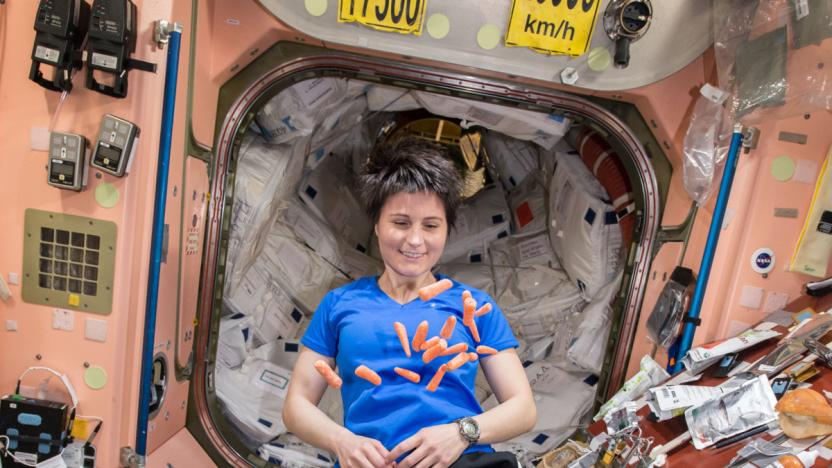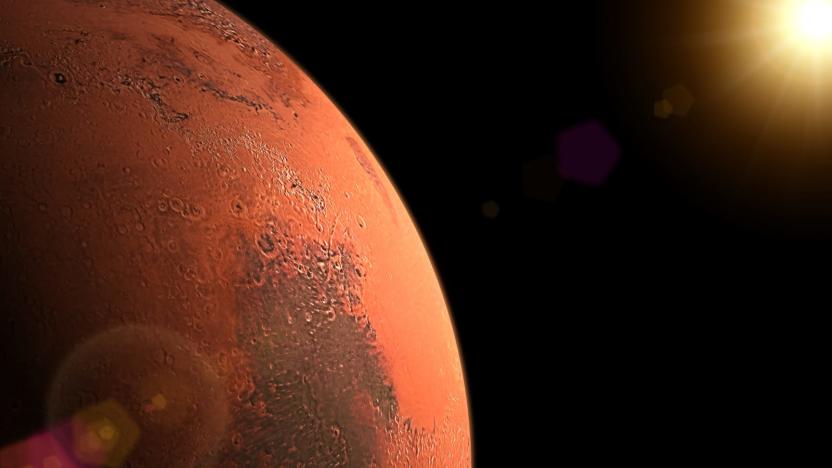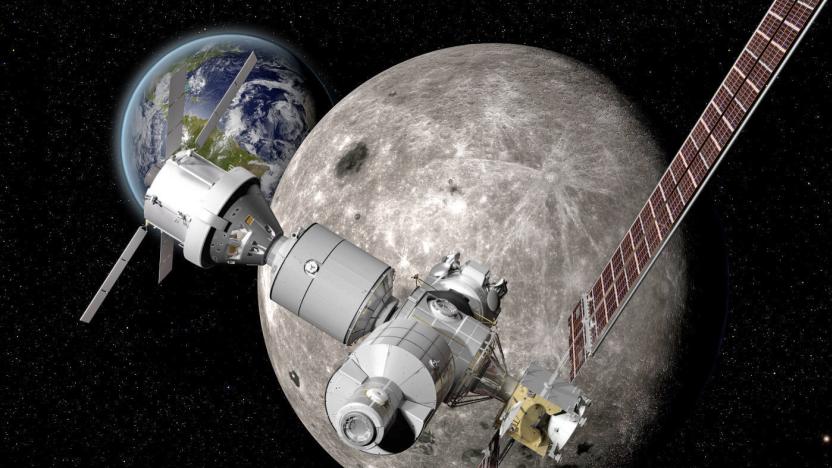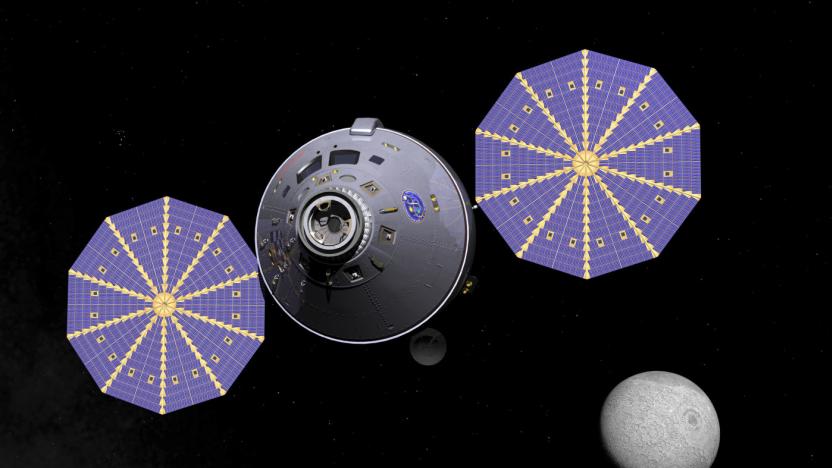deepspace
Latest

Scientists explore using astronaut poop to make space food
Astronauts aboard the ISS drink recycled pee for a reason: we can only bring so much food and water to to space. Imagine how much more we need to take for that year-long journey to Mars. Since bringing more resources means higher costs -- the heavier a spacecraft is, the more fuel it needs, after all -- scientists are looking to find ways to make self-sustaining vehicles. A team of researchers from Penn State University, for instance, have developed a method to make space food with astronaut poop.

Optical laser uses shockwaves to peer inside distant planets
Scientists at SLAC's National Accelerator Laboratory are able to peer even further into space thanks to an improved optical laser. The laser uses shockwaves to create high pressure conditions in materials, and the material's response is then captured by an ultra-bright X-ray laser, revealing what's going on inside planets and meteors. Upgrades to the optical laser means it's now three times more powerful, with the equivalent power of 17 Teslas discharging their 100 kilowatt-hour batteries in a single second.

Boeing's deep space habitat could be home for Mars astronauts
NASA teamed up with six companies to develop deep space vehicles as part of its NextSTEP program last year. Boeing, one of the six, has now given us an idea of what its creations could look like. The company has revealed concept images of its deep space habitat and transport vehicle that could make it possible to send humans to Mars from a lunar base. Pictured above is the Deep Space Gateway, the habitat Boeing wants to send to cislunar space. It could house critical research for human exploration and could dock other vehicles using a system similar to the International Space Station's.

Deep space travel might play havoc with your heart
Traveling deeper into space may carry some unanticipated health risks. Scientists have published a study noting that Apollo astronauts have died of heart disease at an unusually high rate -- of the 7 that passed away during the study, 43 percent fell to cardiovascular conditions. Only 11 percent of those deceased astronauts who stopped at low Earth orbit succumbed to heart disease, which is about on par with the 9 percent rate on the ground. There's a concern that the increased dose of radiation in deep space, however brief, is intense enough to mess with the functioning of cells that line blood vessels.

ICYMI: Raining tiny satellites and the laundry-folding machine
Today on In Case You Missed It: A company called FoldiMate is selling a standalone machine to sit alongside a washing and dryer and fold about 20 garments at a time for $850. Cornell University engineers are sending tiny interstellar computers to the ISS this summer, there they will act as satellites and, eventually, collect information from our nearest neighboring star system, Alpha Centauri. We also round up the week in our TL; DR segment. If you grew up playing The Sims, this piece of news might interest you. We're also very interested in the Visa payment ring the Olympic athletes can wear in Rio. As always, please share any great tech or science videos you find by using the #ICYMI hashtag on Twitter for @mskerryd.

NASA picks solar power candidates for deep space missions
NASA is going to need solar power if it wants to keep its future deep space missions running, and that means getting someone to build that light-gathering technology. Fortunately, the agency has some partners lined up. It just picked four solar power technology proposals that could find their way into spacecraft traveling as far as Mars. The outfits negotiating deals are definitely ones you'll know -- ATK, Boeing, Johns Hopkins University and NASA's own Jet Propulsion Laboratory are all developing systems that collect solar energy in the unforgiving conditions beyond Earth.

NASA's growing flowers on the ISS for the first time
Following upon its initial successes with lettuce back in August, NASA astronauts aboard the International Space Station are attempting to coerce a colony of zinnias to flower for the first time. The effort is part of the larger Veggie plant growth system which is studying the effects of microgravity on plant life.

NASA needs lightweight spacecraft materials to explore the universe
While NASA has been able to go where it wants using existing materials for spacecraft, lightweight ones will enable the agency to explore more places in our solar system and beyond. That's why NASA is now investing in the development of ultra-lightweight (ULW) materials that could reduce a spacecraft's mass by up to 40 percent. That will allow the agency to save on fuel and carry more payload -- or people, in the case of manned missions -- if necessary. In its quest to find light but strong materials, NASA has chosen three proposals from American companies listed below the fold.

Hubble's latest deep field imagery is the most colorful picture of the universe we've ever taken
Want to feel amazed, isolated and inspired all at the same time? Look to the stars. From here on Earth, space seems like an endless empty void -- but anybody familiar with NASA's Hubble Space Telescope know things look a bit more lively from orbit. For the last decade, the orbiting machinery has been snapping photos of deep space, giving us stunning views of stars and galaxies far beyond our reach. This week NASA released the telescope's most recent composite image: the Hubble Ultra Deep Field 2014 (pictured above). It's gorgeous, stunning and a tad overwhelming. NASA says it's also made up of the most colorful deep space images ever captured.

NASA investigates how to keep crew healthy during deep space missions
Now that we're this close to sending humans to Mars, NASA thought it best to start preparing for one of its biggest goals: deep space exploration. Three NASA Ames Research Center studies that aim to explore the effects of deep space exploration on astronauts' health just got a total of $17 million in funding. One of the proposals is looking for ways to mitigate spatial disorientation after a lengthy space flight, while another will use rats to determine how the skeleton will respond to a long exposure to microgravity. The last proposal hopes to develop augmented displays for robotic missions sent to the surfaces of planets, moons, asteroids and the like. NASA's hoping these studies can shed light on how deep space missions affect human eyesight, bone density, and cardiovascular functions, not to mention their impact on people's behavioral and mental health. Of course, $17 million likely won't be enough to get all the answers we're looking for, but that can at least keep those studies chugging along for one to three years. [Image credit: NASA]

NASA is looking for an alternative to battery power for its spacecraft
NASA knows that conventional battery power won't cut it at a certain point, especially when the agency's vehicles travel into deep space. To that end, it's asking both public institutions and companies to submit proposals for battery alternatives. The initiative will tackle both low-level energy cell design, such as chemistry and packaging, as well as advanced devices that could outperform existing lithium cells. Ideally, NASA will get energy storage that provides more power without taking a hit to either longevity or safety. [Image credit: NASA]

ILOA details its ILO-X lunar telescope, wants it on the Moon in 2015
The International Lunar Observatory Association and Moon Express have spent years working on their privately-backed, Moon-bound ILO-X telescope. Today, they can finally share the nuts-and-bolts details of their flight test hardware. Not surprisingly, the roughly shoebox-sized device won't come close to matching Hubble between its tiny 130mm, f/5.6 aperture and 6.4-megapixel resolution. However, oneupmanship isn't the point -- ILOA mostly wants its inaugural telescope to be accessible enough that schools, scientists and the public at large can get a peek at deep space through the internet. Most of the challenge rests in getting ILO-X to its ultimate destination. Moon Express won't deliver the telescope to the Moon until sometime in 2015, which will leave us waiting some time for another vantage point on the universe.

Australia Square Kilometre Array Pathfinder goes live as the world's quickest radio telescope
Australia's Shire of Murchison is quickly becoming a hotbed for radio telescopes. As of of Friday, the territory is operating the world's fastest radio telescope in the form of the Australia Square Kilometre Array Pathfinder (ASKAP). The 36-antenna grid's eventual use of six phased array feeds, each with 188 receivers, will let it scan a field of view 150 times larger than the moon's visible area while processing that information much faster than a typical single-pixel radio telescope feed -- CSIRO estimates that an image of the Centaurus A galaxy that would take 10,000 hours to process with rivals should take five minutes with ASKAP. Ultimately, the array should grow to 60 antennas as part of the Square Kilometer Array, which includes South Africa in its hunt for pulsars, quasars and other unique parts of the universe. Just don't get your hopes up for booking alien listening sessions anytime soon. Commissioning started virtually as soon as the ribbon was cut, and scientists have already scheduled their usage slots for the next five years. We're sure we'll get over any frustration when we see the first ASKAP results published within the next year.

IBM cluster powers Murchison Widefield Array's radio telescope, answers mysteries of the universe faster than ever (video)
Radio telescope operators have as much of a problem coping with the avalanche of data as getting that information in the first place. The Victoria University of Wellington is all too aware and is leaning on IBM for a powerful (if very tongue-tying) iDataPlex dx360 M3 compute cluster to sift through the deluge at the upcoming Murchison Widefield Array. Combined, the 4,096 array antennas probing deep space and solar atmospherics will have the Xeon-based cluster tackling signal data to the tune of 8GB per second, and about 50TB per day -- that's a Nexus 7's worth of astronomy faster than you can sneeze, folks. A 10Gbps network connection will feed the results to Perth to save scientists a roughly 435-mile trek. Construction is still in mid-stride, but the $51 million Australian ($52.2 million US) being spent on the Murchison array may be worthwhile if it helps solve the riddles of star formation and solar flares.

NASA collects proposals for space fueling stations
Sometimes rocket science is actually, you know, rocket science. Getting to the moon was tough enough, but deep space exploration poses all manner of additional concerns -- like getting back home alive, for one thing. And then there's the issue of fuel, something long distance trips require a lot of -- but stocking up on here on Earth means potential weight problems at launch. One proposal offered up in the past is space-based fueling stations conveniently located in key spots on the way to a distant destinations like the Moon, Mars, and asteroids. NASA is collecting proposals that can demonstrate the validity of such a plan, including the ability to store liquid oxygen and hydrogen, transfer it, and have a ship approach for fueling. If you think you've got your bases covered -- and can keep it under $200 million -- you've got until May 31st at 11:59 PM EST to hand over a proposal.

Chicago's Adler Planetarium to start projecting 8K by 8K images from this July, put cinema screens to shame
Okay, so it's not quite 8K video, we're not there yet, but the Adler Planetarium and its brand new Grainger Sky Theater are about to show us what 64 megapixel images look like on a big screen. Described as the "largest single seamless digital image in the world," the picture inside the planetarium will come from 20 projectors hooked up to 45 computers processing data, and should provide the most lucid and captivating view unto our universe that one can get without actually exiting the Earth's atmosphere. The new show kicks off on July 8th, having been put together with aid from NASA and IBM among others. Jump past the break for the full press release.






